When valuing beaded pieces, you’ll need to examine material composition, with glass beads commanding higher prices than plastic or wood. Assess craftsmanship through bead placement uniformity, threading durability, and stitching patterns. Document historical significance and cultural provenance, as Northern Plains Native American pieces or Venetian glass origins increase value. Evaluate structural integrity, photograph damage systematically, and research comparable sales data from auction houses and galleries. Understanding these expert methods will reveal the detailed framework professionals use to determine authentic worth.
Understanding Bead Materials and Construction Quality
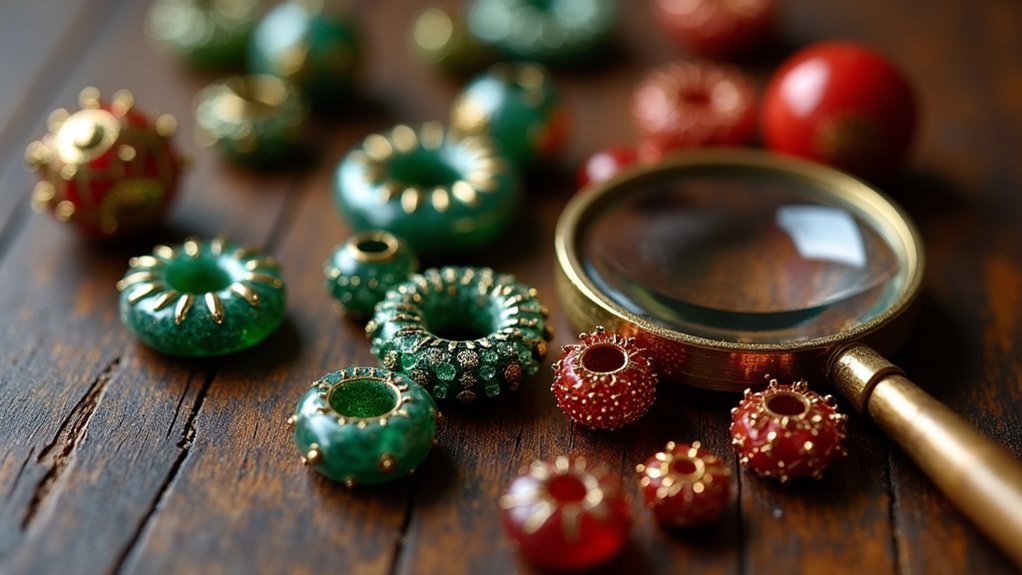
When evaluating beaded pieces, you’ll find that material composition serves as the foundation for determining value. Glass beads typically command higher prices than plastic or wooden alternatives due to their superior craftsmanship and visual appeal.
Material composition forms the cornerstone of bead valuation, with glass pieces consistently outperforming plastic and wooden counterparts in both quality and market price.
You’ll want to examine each bead’s clarity, color consistency, and surface finish when appraising quality.
Construction quality demands careful scrutiny of bead placement uniformity and threading durability. Check whether beads sit evenly without gaps or looseness, as tight, consistent spacing indicates skilled workmanship. The backing materials and thread strength directly impact longevity and value.
Don’t overlook provenance when evaluating bead materials. Documented origins, especially pieces linked to renowned artisans or cultural significance, substantially increase worth.
Antique Venetian glass or millefiori beads carry premium valuations due to their historical importance and unique manufacturing techniques.
Identifying Historical and Cultural Significance
Beyond material quality, you’ll discover that historical and cultural significance dramatically influences a beaded piece’s value and authenticity.
When examining Northern Plains Native American beadwork, you’re analyzing more than decorative elements—you’re uncovering indicators of social status, cultural identity, and historical trade relationships. These pieces reveal specific tribal techniques and traditional designs that connect to particular regions and time periods.
Age and documented provenance dramatically affect market value, with older pieces commanding higher prices.
You’ll need to identify bead origins, such as Venetian glass or French brass, which indicate trade influences and geographical authenticity. Understanding functional purposes—whether ceremonial or utilitarian—adds essential context to cultural significance.
This knowledge directly impacts how collectors and institutions value these historically important artifacts.
Assessing Condition and Preservation State
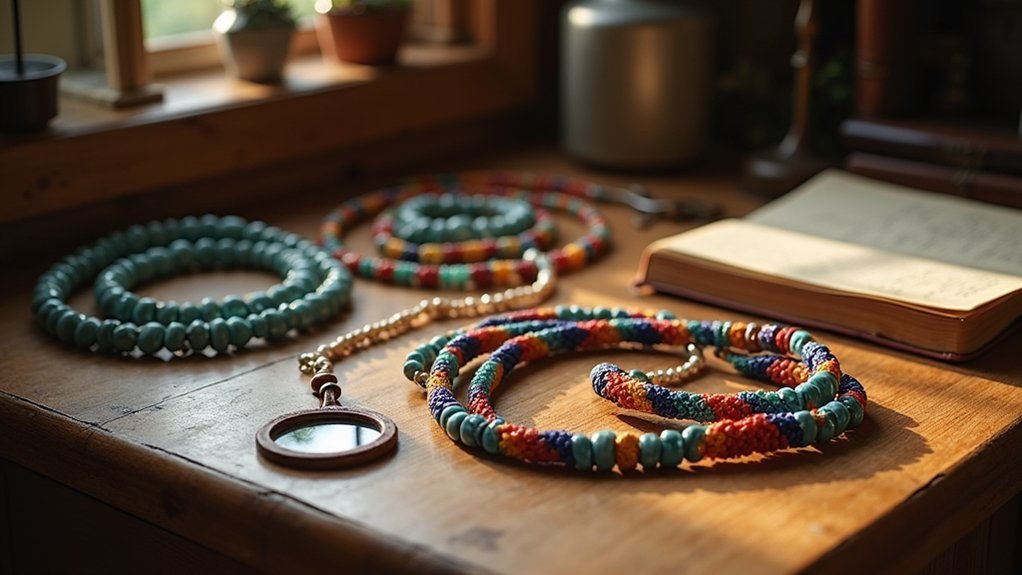
When you’re evaluating beaded pieces, you’ll need to conduct a thorough structural integrity assessment to determine the item’s current condition.
Start by examining the foundation materials, thread tension, and overall construction stability to identify any weaknesses or potential failure points.
You must also create detailed documentation of any existing damage, including photographing missing beads, frayed areas, loose connections, or discoloration that could affect the piece’s value.
Structural Integrity Assessment
The careful examination of a beaded piece’s structural integrity forms the foundation of accurate valuation, as even minor deterioration can greatly impact both worth and collectibility. You’ll need to scrutinize every aspect of the preservation state during your appraisal process.
Focus on close-up photography to capture critical details like fraying threads, missing beads, or backing fabric deterioration. Historical construction methods directly influence longevity, so you must understand how different bead application techniques affect structural stability.
| Assessment Area | Key Indicators |
|---|---|
| Thread Condition | Fraying, brittleness, breaks |
| Bead Security | Loose, missing, or damaged beads |
| Backing Material | Tears, staining, fabric degradation |
Consider how maintenance history and storage conditions have preserved or compromised the piece’s structural integrity, as these factors considerably influence market value.
Documentation of Damage
Accurate damage documentation requires systematic photographic evidence and detailed written records that capture every flaw, no matter how minor it appears.
You’ll need high-resolution images showing fraying threads, missing beads, discoloration, and structural weaknesses from multiple angles. Document each issue’s location, size, and severity using standardized terminology that appraisers understand.
Your written records should complement photographs with precise descriptions of deterioration patterns, noting thread brittleness and color fading intensity.
This documentation of damage becomes essential during formal appraisals, as it establishes baseline conditions for insurance and resale purposes.
Include provenance information alongside your condition assessment, since historical significance can offset physical imperfections in valuation.
Remember that transparent damage reporting enhances credibility with potential buyers and authenticates your piece’s current state.
Determining Age Through Bead Manufacturing Techniques
You can determine a beaded piece’s age by examining how its glass beads were manufactured, since hand-blown Venetian glass from the 16th century differs markedly from modern machine-made versions.
The construction materials tell their own story—traditional sinew threading points to indigenous craftsmanship from earlier periods, while synthetic threads suggest more recent production.
Commercial trade patterns also provide dating clues, as certain bead types only became available through specific trade routes during particular historical periods.
Glass Bead Origins
When examining glass beads to determine their age, you’ll find that manufacturing techniques serve as reliable historical markers. Different production methods reveal distinct time periods and geographical origins that directly impact market trends for collectors and appraisers.
Key indicators help identify glass bead origins:
- Millefiori techniques – Italian craftsmanship with distinctive floral patterns embedded in glass
- Aurora Borealis finish – 1950s development creating rainbow-like surface effects on beads
- Drawn versus pressed glass – Hand-drawn methods indicate earlier periods, while pressed glass suggests mass production
- Lampwork construction – Flame-worked beads showing regional manufacturing characteristics
Mass production from the 19th century made glass beads widely available, including those used in NATIVE AMERICAN trade relationships.
You can date pieces by examining iridescence, opacity, and color techniques that became popular during specific eras in bead-making history.
Sinew Construction Methods
Beyond glass composition itself, the construction materials holding beads together provide essential dating evidence for authentic Native American pieces.
When you’re examining beadwork, sinew construction immediately signals historical authenticity. This animal tendon threading, particularly when aged or weathered, indicates pre-synthetic material origins, typically placing creation in the late 19th century or earlier.
You’ll want to assess the sinew stitching quality carefully. Finer, more intricate patterns demonstrate superior craftsmanship that directly impacts current value.
Expert appraisers featured on ANTIQUES ROADSHOW consistently emphasize analyzing bead application methods—sinew versus thread or glue reveals technological context and artistic practices of specific time periods.
The presence of sinew construction helps you determine both cultural authenticity and chronological placement, making it invaluable for accurate valuation assessments.
Commercial Trade Influences
How can you distinguish between a treasured 1800s ceremonial piece and a 1960s tourist souvenir?
You’ll need to examine the commercial trade influences that shaped bead availability during different eras. Historical trade routes brought specific bead types to various regions at distinct times, creating chronological markers for appraisers.
Key indicators include:
- Venetian glass beads – Popular in early trade periods, indicating 18th-19th century origins
- Italian millefiori patterns – Complex designs that mark specific manufacturing periods
- Aurora borealis finishes – Distinctive iridescent coating introduced in the mid-20th century
- Mass-produced uniformity – Modern pieces show consistent sizing versus handmade variations
You’ll also notice that commercial leather replaced traditional materials in later pieces, reflecting changing trade practices and manufacturing accessibility that help pinpoint production timeframes.
Evaluating Craftsmanship and Artistic Merit
Although determining a beaded piece’s worth requires multiple considerations, you’ll find that evaluating craftsmanship and artistic merit forms the foundation of accurate valuation.
Craftsmanship and artistic merit serve as the cornerstone for determining any beaded piece’s true market value.
You should examine the intricacy of beadwork, focusing on stitching patterns and precise bead placement that demonstrate technical skill. Don’t overlook material quality—superior beads and threads indicate higher craftsmanship levels.
When analyzing artistic merit, you’ll want to assess the design’s originality and cultural significance. Consider the piece’s historical context and its maker’s background, as these elements directly impact value.
You should also evaluate how traditional techniques intersect with innovative approaches.
Remember that exceptional craftsmanship combined with strong artistic merit creates pieces that transcend mere decoration, becoming valuable cultural artifacts that collectors actively seek in today’s market.
Authentication Methods for Antique Beadwork
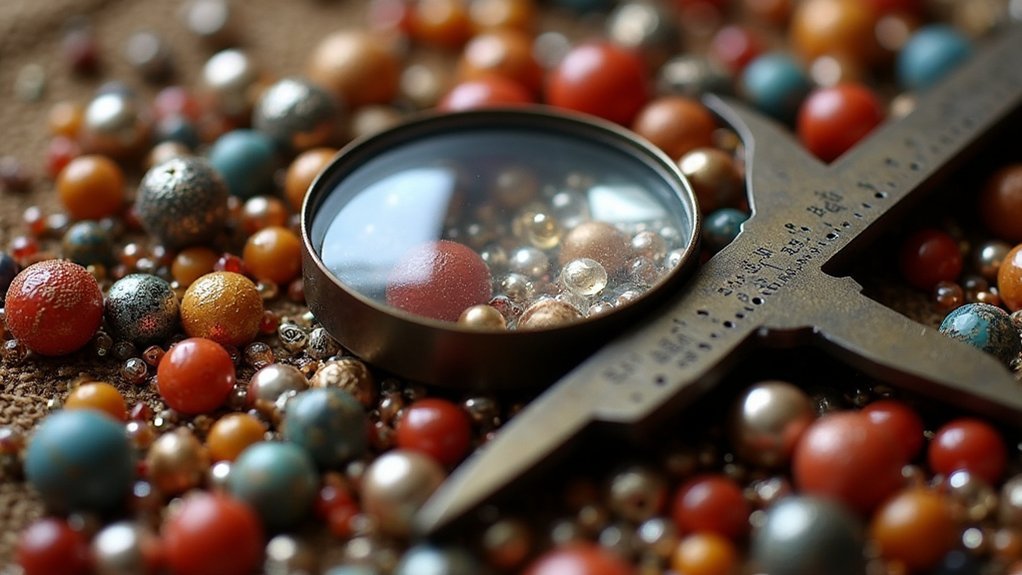
When you’re authenticating antique beadwork, material analysis serves as your primary starting point for verification. You’ll examine the beads themselves—whether they’re glass, brass, or other materials—alongside the thread or sinew used in construction. These elements reveal significant information about cultural origin and age.
Your authentication process should include:
- Provenance research – Tracing ownership history to confirm authenticity and cultural significance
- Pattern analysis – Studying design techniques to identify specific tribal or regional origins
- Comparative evaluation – Cross-referencing with authenticated pieces in museum collections
- Documentation review – Examining photographs, appraisals, and sales records for verification layers
Each tribe maintains distinct beadwork styles and application methods, making pattern recognition essential.
You’ll compare suspected pieces against known authentic examples to identify forgeries and assess craftsmanship quality effectively.
Market Analysis and Comparable Sales Research
You’ll need to examine historical sales data to establish pricing patterns for beaded pieces over time.
Regional market variations can greatly impact values, as certain styles may be more coveted in specific geographic areas.
Understanding the differences between auction and retail markets will help you determine the most appropriate valuation context for your piece.
Historical Sales Data
Three fundamental data sources form the backbone of historical sales analysis for beaded pieces: auction records, gallery sales, and private dealer transactions.
You’ll need to examine these sources systematically to establish accurate valuations. When you analyze historical sales data, you’re identifying market patterns that directly impact current pricing.
Focus on these key research areas:
- Auction house results – Review major auction catalogs and realized prices for comparable beaded works
- Gallery retail prices – Track pricing from established dealers specializing in beadwork
- Documented provenance trails – Trace ownership history and previous sale records
- Market timing factors – Consider seasonal trends and economic conditions affecting sales
You’ll find that pieces with detailed sales histories command premium prices because they offer collectors confidence in authenticity and investment potential.
Regional Market Variations
While national trends provide baseline valuations, regional markets create distinct pricing landscapes that can dramatically affect your beaded pieces’ worth.
You’ll find that demand and buyer preferences vary considerably across geographic locations, making regional research essential for accurate appraisals.
In the Southwestern United States, beaded items with historical or cultural significance command premium prices due to the region’s rich beadwork heritage.
You should research comparable sales from your specific area, examining recent auction results and local gallery transactions.
Local economic factors heavily influence pricing.
Areas with established collectors or galleries specializing in indigenous art create stronger markets for beaded pieces.
You’ll also notice seasonal fluctuations during cultural events like art fairs or Native American heritage festivals, which temporarily increase visibility and buyer interest.
Auction Vs Retail
Understanding the difference between auction and retail markets proves essential for accurate beaded piece valuations.
You’ll find these markets operate differently, affecting how you should price your pieces. Auction environments create competitive bidding that can drive prices above retail estimates, especially for rare or highly sought-after items.
However, you’re also risking lower returns if buyer interest wanes.
- Auction prices fluctuate based on bidder competition and item rarity
- Retail valuations include overhead costs and profit margins in pricing
- Comparable sales research establishes baseline pricing for both markets
- Market trends influence demand across auction houses and retail stores
You must analyze recent comparable sales to establish realistic expectations.
Consider your piece’s condition, craftsmanship quality, and current market trends when choosing between auction consignment or retail sales.
Documentation and Provenance Verification
Although beaded pieces may appear deceptively simple, their true value often hinges on the strength of their documentation and verified provenance.
You’ll need detailed photographs capturing every angle, extensive material descriptions, and any known ownership history to maximize your piece’s valuation. Provenance verification becomes vital as you trace the item’s journey through previous owners, establishing both authenticity and cultural significance.
When you’re preparing for appraisal, gather all supporting evidence including receipts, previous appraisals, and expert opinions about cultural context.
Don’t overlook documentation of restoration work – while conservation can preserve your piece, undisclosed modifications will impact its value. Your appraiser relies heavily on this documented evidence to support their valuation, making thorough record-keeping essential for accurate assessment.
Professional Photography Requirements for Appraisal
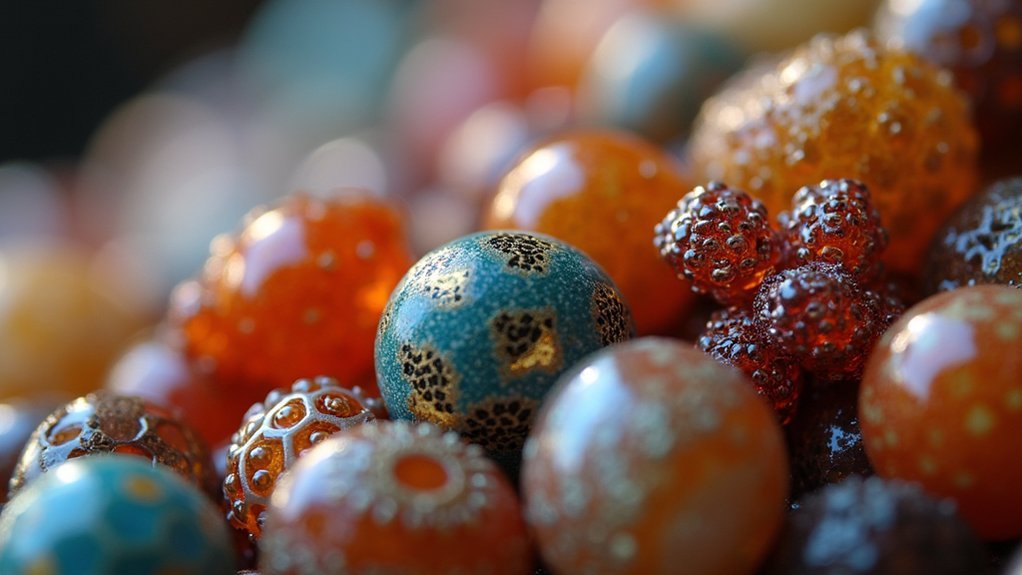
Professional photography serves as the foundation for accurate beaded piece appraisals, transforming visual documentation from merely helpful to absolutely critical.
You’ll need to capture thorough images that reveal every detail affecting your piece’s value.
Essential photography requirements include:
- Overall and closeup shots – Wide views establish size and design context while detailed images expose intricate beadwork, materials, and potential damage.
- Natural lighting conditions – Avoid artificial lights that distort colors and misrepresent the true hues of your beads.
- Neutral, distraction-free backgrounds – Clean backdrops focus attention entirely on your pieces, enabling clearer quality assessment.
- Multiple angles with maker’s marks – Document all sides, labels, and signatures to verify authenticity and origin information.
These photography standards guarantee appraisers receive complete visual information necessary for accurate valuations.
Current Market Trends Affecting Beaded Jewelry Values
Current market dynamics greatly influence your beaded jewelry’s appraisal value, with fashion trends creating substantial price fluctuations that can either boost or diminish worth.
Vibrant colors and unique designs currently command premium prices, while handmade artisanal pieces using traditional techniques experience heightened demand and valuations.
You’ll benefit from expanded market access through online platforms like Etsy and eBay, reaching niche audiences willing to pay better prices.
Vintage and antique beaded items with historical significance attract collectors, driving values upward considerably.
Seasonal trends also impact your pricing strategy. Holiday-themed and festival-ready pieces see temporary value spikes during specific periods.
Understanding these market forces helps you time appraisals strategically and position pieces advantageously for maximum valuation returns.
Frequently Asked Questions
How Do You Get Rare Items Appraised?
You’ll need clear photos and detailed history of your item. Submit to verified experts on platforms like JustAnswer or Mearto. For valuable pieces, get multiple appraisals to establish reliable market value.
How Do You Know if the Jewelry Appraiser Is Trustworthy?
You’ll verify their credentials through ASA or ISA memberships, read client reviews, confirm their jewelry specialization experience, ask about their valuation methodology, and guarantee they provide detailed written reports for transparency.
Are Jewelry Appraisals Worth It?
You’ll find jewelry appraisals worthwhile if you’re insuring valuable pieces, planning estate matters, or selling jewelry. They’ll protect you from financial losses and strengthen your negotiating position with documented valuations.
How to Learn Jewelry Appraisal?
You’ll need to study gemstones, metals, and craftsmanship fundamentals. Take courses from recognized institutions, gain hands-on experience through internships with established appraisers, and stay current with market trends through industry publications.
In Summary
You’ll find that successfully appraising beaded pieces requires mastering multiple evaluation criteria simultaneously. Don’t overlook any single factor—materials, age, craftsmanship, and market conditions all impact final valuations. You’re building expertise through systematic analysis of each component, from bead construction techniques to provenance documentation. Remember that you’ll need professional photography and current market research to support your conclusions. Practice consistently, and you’ll develop the keen eye that distinguishes valuable pieces from ordinary ones.

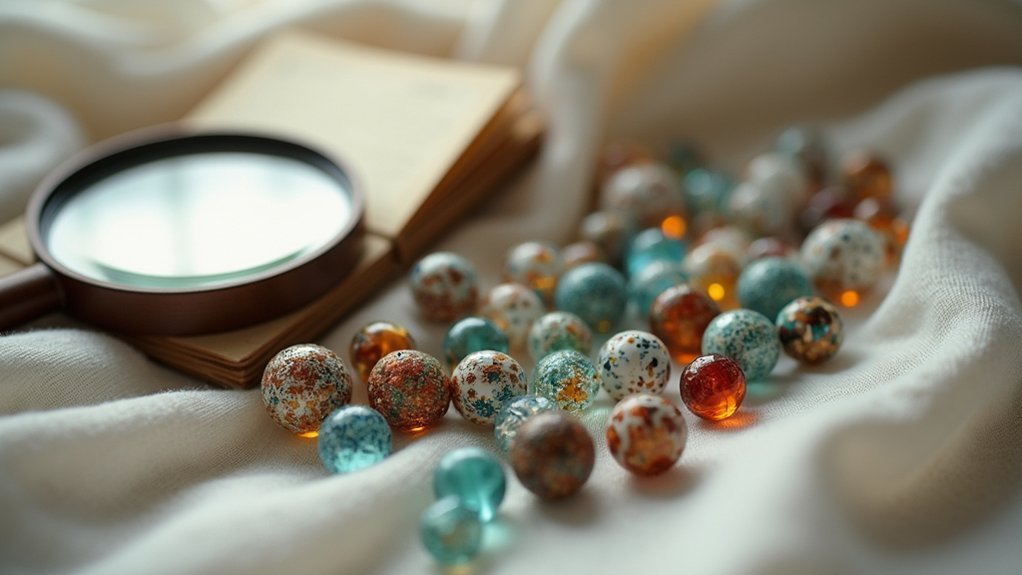
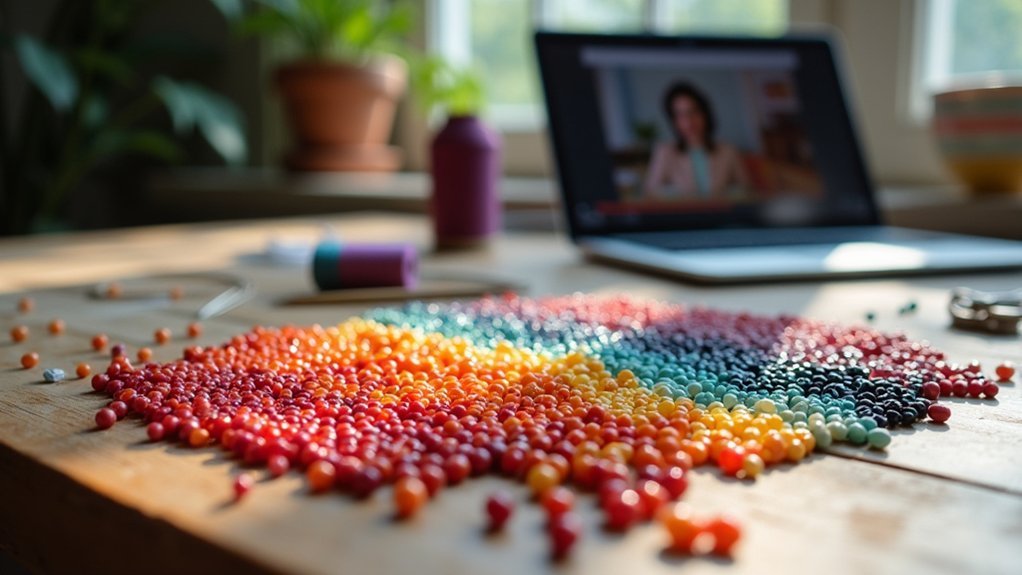
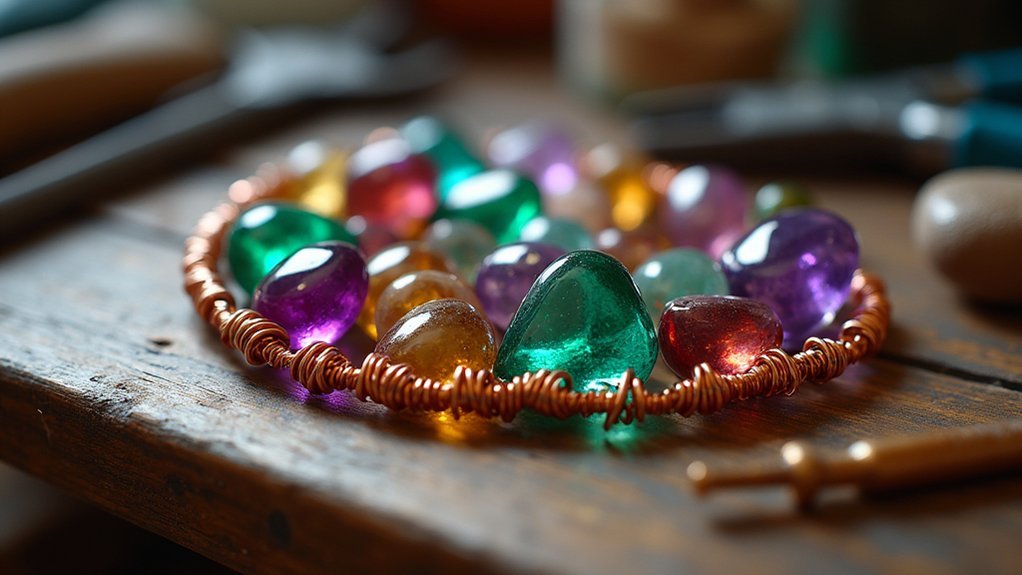

Leave a Reply